Young Worker Safety in Restaurants eTool
Young Worker Safety in Restaurants » Clean-up

Clean-up
The Clean-up area of a restaurant offers young workers an opportunity to learn clean-up duties while handling various equipment and products. Young workers in this area may also be exposed to the following hazards:
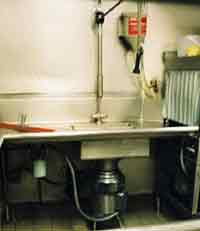
Potential Hazard
Exposure of young restaurant workers to burns and scalds while performing clean-up tasks such as loading or unloading automatic dishwashers, continuous-feed dishwashers, and glass washers or while washing dishes and pots.
Possible Solutions
Employers have the primary responsibility for protecting the safety and health of their workers. Employees are responsible for following the safe work practices of their employers.
-
Do not try to unload dishes or glasses until they are cooled.
-
Avoid steam; it can burn.
-
Open hot water faucets slowly to avoid splashes.
-
Test water temperatures in sinks before sticking your hands into them.
Employers have the primary responsibility for protecting the safety and health of their workers. Employees are responsible for following the safe work practices of their employers.
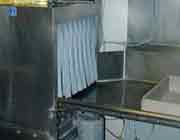
Follow OSHA Standards including:
- Provide machine guards to protect the operator and other employees in the machine area from hazards. Machine Guarding Standard [1910.212(a)(1)].
- Continuous-feed dishwashers and glass washers should be properly guarded to prevent accidental scalding of workers by steam and hot water and possible injuries from rollers and conveyors.
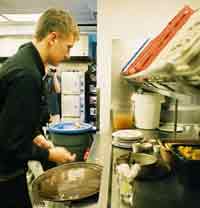
Potential Hazard
Restaurant workers can be at risk for cuts while performing clean-up tasks, such as cleaning up broken glass, handling sharp utensils (like knives), clearing tables, washing dishes, or cleaning restrooms.
Possible Solutions
Employers have the primary responsibility for protecting the safety and health of their workers. Employees are responsible for following the safe work practices of their employers.

-
Use any personal protective equipment your employer provides, including special gloves for clean-up duties.
-
Use a broom and dustpan to clean up broken glass; do not use your hands.
-
Let a falling knife fall. Do not try to catch it.
- Do not store knives and other sharp objects in sinks between periods of use. An unsuspecting person could reach in and get cut.
-
Clean the knife immediately after use or place it in a dishwasher or a container labeled "for knives only."
-
- Exposure to used needles is a growing concern, as customers with diabetes and other illnesses may need to give themselves medications while in the restaurant. You can protect yourself from this hazard by doing the following:
- Wear provided personal protective equipment, especially heavy-duty gloves, while cleaning the bathroom.
- Do not touch any needles or drug items. If you see these anywhere, report it to your supervisor.
- Do not compress garbage bags with your body (for example, stepping on a bag to smash it down); sharp items inside may stick or cut you.
- Report immediately to your supervisor if you think you have been stuck or cut by a needle or any object that you believe has human blood on it.
Employers have the primary responsibility for protecting the safety and health of their workers. Employees are responsible for following the safe work practices of their employers.
Follow OSHA Standards including
-
Provide and require employees to use appropriate hand protection if they are exposed to hazards such as cuts, lacerations, or puncture injuries. Hand Protection Standard (1910.138(a)).
-
Employees in restaurants are not generally considered to have exposure to human blood. If however, occupational exposure to human blood can be reasonably anticipated, then employers are required to comply with the Bloodborne Pathogens Standard.
Consider implementing recommended safe work practices, including:

-
Train all employees to respond to any situation where used needles are discovered by avoiding contact and calling their supervisor.
-
Consider providing needle disposal containers in restaurant bathrooms as a customer service for those guests who self-administer injectable medications. This enables them to properly dispose of the device and protects employees from accidental needlesticks.
-
Send any employee who sustains a needlestick or injury from a sharp that has human blood on it for emergency medical evaluation. Time is critical!
 For more information on knife safety, see Food Preparation - Knives and Cuts.
For more information on knife safety, see Food Preparation - Knives and Cuts.
Additional Resources
-
Selecting, Evaluating, and Using Sharps Disposal Containers. U.S. Department of Health and Human Services (DHHS), National Institute for Occupational Safety and Health (NIOSH) Publication No. 97-111, (January 1998). NIOSH's safety performance criteria for selecting, evaluating, and using sharps disposal containers.
-
Quick Reference Guide to the Bloodborne Pathogens Standard. OSHA.
Potential Hazards

Young restaurant workers may be exposed to electric shock or electrocution hazards during clean-up due to contact with:
-
Faulty electrical appliances or contact with an energized source that may be in use in the commercial kitchen
-
Worn electric cords, or improperly used or damaged extension cords
-
Improperly wired or ungrounded outlets
-
Faulty equipment and wiring
-
Damaged receptacles and connectors
-
Wet clean-up processes
-
Unsafe work practices
Possible Solutions
Employers have the primary responsibility for protecting the safety and health of their workers. Employees are responsible for following the safe work practices of their employers.

-
Identify and report any workplace hazards to supervisors.
-
Attend any training meetings provided by employer.
-
Report any unsafe working conditions to supervisor.
Eliminating electrical hazards through safeguards and safe work practices including:
-
Use ground fault circuit interrupters (GFCIs) receptacles for your own protection if they are available. Encourage employers to install these lifesaving, inexpensive devices. See ground-fault circuit interrupters (GFCIs).
-
Become educated about electrical hazards. Understand how potential electrical accidents may occur and how to help avoid them. For example:

- Do not put your fingers or other materials on the prongs of a plug while you are inserting it into an outlet. Keep your hands well back on the plug.
- Remove plugs from receptacles by pulling on the plug, not the cord. Pulling on the cord could damage the cord and increase the risk of shocks.
-
Do not use damaged cords or receptacles. This may promote shocks.
-
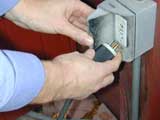
Understand that touching the outside of a metal outlet box with one hand while plugging in an appliance with the other hand may complete the electrical "circuit," forcing current through you and exposing you to possible shock or electrocution.
-
Do not plug in electrical equipment with wet hands or while touching a wet or damp surface
-
Use plugs and receptacles that have been designed to prevent energization until insertion is complete.
Know emergency procedures and policies for electrical emergencies at work including:
-
Learn how to shut off the current (such as flip breakers, or lever switch, etc.) in case of an emergency.
-
Make sure electrical control panels are properly labeled.
-
Never touch an electrocution victim until the power has been turned off.
-
Never use faulty equipment or damaged receptacles and/or connectors.
-
Never plug in electrical equipment with wet hands or while touching a wet or damp surface.
-
Learn how to perform CPR.

Follow OSHA Standards including:
- Ensure that all electrical service near sources of water is properly grounded. Electrical Standard [1910.304(g)(6)(vi)(C)(5)].
-
Grounding requirements for equipment connected by cord and plug. OSHA Standard Interpretation, (December 21, 1999)
-
-
Ensure electrical equipment shall be free from recognized hazards [1910.303(b)(1)].
-

Tag out and remove from service all damaged receptacles and portable electrical equipment [1910.334(a)(2)(ii)].
-
Repair all damaged receptacles and portable electrical equipment before placing them back into service [1910.334(a)(2)(ii)].
-
Ensure that employees are trained to not plug or unplug energized equipment when their hands are wet [1910.334(a)(5)(i)].
-
Keep aisles and passageways clear and in good repair, with no obstruction across or in aisles that could create a hazard. Provide floor plugs or ceiling plugs for equipment so power cords need not run across pathways. Walking-working Surfaces Standard [1910.22(a)].
 For more information, see General Hazards - Electrical Hazards.
For more information, see General Hazards - Electrical Hazards.
Additional Resources
-
25-Year-Old Restaurant Manager Electrocuted in North Carolina. National Institute of Occupational Safety and Health (NIOSH) Fatality Assessment and Control Evaluation (FACE) Report 86-43.
-
Control of Hazardous Energy (Lockout/Tagout). OSHA Safety and Health Topics Page.
-
Preventing Electrocutions of Workers in Fast Food Restaurants, National Institute of Occupational Safety and Health (NIOSH) Publication Number 95-104, (December 1984).
Potential Hazards

Exposure of young restaurant workers to potentially hazardous chemicals such as oven cleaners, floor cleaners, pesticides, disinfectants, drain cleaners, soaps, detergents, and latex.
-
Soaps and detergents may cause allergic reactions and skin irritation.
-
Broken skin from soap or detergent irritation may provide an avenue for infection or injury if exposed to chemical hazards.
-
Drain cleaners, oven cleaners, and grill cleaners solutions and sprays can be caustic and can cause skin burns and eye and skin irritations.
-
Ammonia, used as a cleaning agent, and chlorine solutions, used as a disinfectant in dishwashing, can cause skin, eye, and nose irritations. Caution: Mixing chlorine and ammonia solutions will result in a chemical reaction and may release deadly chlorine gas.
-
Latex gloves, worn to protect the hands from chemicals, may cause skin irritation or allergic reactions in some young workers.
Possible Solutions
Employers have the primary responsibility for protecting the safety and health of their workers. Employees are responsible for following the safe work practices of their employers.
-
Read the product label and follow instructions and recommendations listed on the label.
-
Use the least toxic cleaning products possible.
-
Use any personal protective equipment provided by your employer such as gloves, eye goggles, and special aprons.
-
Be sure you are properly trained in the need for and use of personal protective equipment.
-
Use appropriate gloves to protect your hands from chemicals and sharp objects.
-
After removing gloves, wash your hands with mild soap and water, and dry thoroughly.
-
Avoid latex gloves if you have been diagnosed with latex allergy.
-
Ask your employer about possible toxic effects of the chemicals you are required to use. You have the right to read Safety Data Sheets (SDS). SDS provide employers and employees with information to protect themselves from hazardous chemical exposures and to work safely with chemical products.
-
Do not mix chlorine bleach and ammonia products together. This combination will create a toxic gas.
Employers have the primary responsibility for protecting the safety and health of their workers. Employees are responsible for following the safe work practices of their employers.
Follow OSHA Standards including:
- If hazardous chemicals are used, employers need to implement a written program that meets the requirements of the Hazard Communication Standard (HCS) to provide for worker training, warning labels and access to Safety Data Sheets (SDS).
- The Hazard Communication Standard ensures employee awareness of the hazardous chemicals they are exposed to in the workplace and how to prevent exposure.
-
Provide Safety Data Sheets for any hazardous chemicals that are used in the workplace.
-
Provide appropriate Personal Protective Equipment (PPE) such as, gloves, goggles, and splash aprons for employees who handle hazardous chemicals including dishwashing detergents, pesticides, etc. [1910.132].
-
Provide suitable facilities for quick drenching or flushing of the eyes and body if exposure to injurious corrosive material is possible. Facilities should be located within the work area for immediate emergency use. Medical Services and First Aid Standard [1910.151(c)].
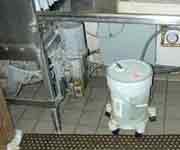
Consider implementing recommended safe work practices, including:
- Use cleaning chemicals that are not considered hazardous.
- Consider automating the dispensing of cleaning chemicals whenever possible to avoid employee contact with chemicals.
- Limit employee contact with dishwashing detergents by providing dishwashing machines with automated detergent dispensers.
-
Workers must still be cautious and use appropriate PPE such as goggles and gloves when changing out detergent containers.
-
-

Ensure that chemicals that are not compatible with each other are not stored together (check SDS).
-
Always label cleaning bottles and containers. Never remove products from the original bottle without properly labeling the new container.
-
Store pesticides in their original labeled container.
-
Avoid storing liquid chemicals on top shelves. Store them on lower shelves.
Additional Resources
-
Hazard Communication. OSHA Safety and Health Topics Page.
-
Small Business Safety and Health Handbook. OSHA Publication 2209, (2024) [Español OSHA Publication 4261, (2024)]. Summarizes the benefits of an effective safety and health program, provides self-inspection checklists for employers to identify workplace hazards, and reviews key workplace safety and health resources for small businesses.
- 29 CFR 1910.1200, Hazard communication. OSHA Standard.
-
Appendix E Guidelines for Employer Compliance with the Hazard Communication standard.
-
-
Latex Allergy. OSHA Safety and Health Topics Page.
Potential Hazard

Exposure of young restaurant workers to injuries due to slips, trips, and falls while performing tasks such as carrying trays or bins of dirty dishes, washing dishes, mopping floors, emptying trash, cleaning, and spraying down parking lots.
Possible Solutions
Employers have the primary responsibility for protecting the safety and health of their workers. Employees are responsible for following the safe work practices of their employers.

-
Keep passageways and walkways free of clutter and crowding.
-
Be sure that rugs and mats are in place.
-
Wipe up spills immediately. "Spot mop" only during busy times.
- Do not overfill bussing containers. Make a couple of trips to "clear" a table. The added time it takes to do the job safely will prevent injures in the long run.
- Overfilling bussing containers can encourage strain injuries if you try to carry a container that is too heavy.
- Overfilling containers is also dangerous because when a container is overfilled, items tend to fall out. If you try to grab the item you may end up dropping the entire container and possibly slipping on or getting cut by broken slippery dishes.
-
Even if items don't fall out of overfilled containers, workers focus so much on keeping everything inside the container that they forget to watch where they are going and trip and fall over objects in the room.
-
Wear appropriate waterproof non-slip footwear. This is especially important if doing wet processes such as spraying down parking lots or mopping floors.
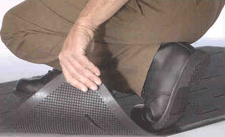
- If available, use slip-resistant overshoes when performing wet or greasy tasks. During wet processes, use the overshoes on top of your existing shoes for non-slip protection. Non-slip shoe covers provide safe footwear for a minimal cost.
Employers have the primary responsibility for protecting the safety and health of their workers. Employees are responsible for following the safe work practices of their employers.
Follow OSHA Standards including:
-
Keep all places of employment clean and orderly and in a sanitary condition. Walking/Working Surfaces Standard [1910.22(a)(1)].
-
Keep floors clean and dry. Where wet processes are used, maintain drainage, and provide false floors, platforms, mats, or other dry standing places where practicable [1910.22(a)(2)].
-
Provide warning signs for wet floor areas [1910.145(c)(2)].
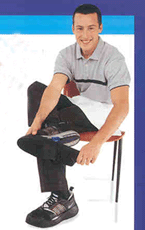
Consider implementing recommended safe work practices, including:
-
Provide non-slip matting in areas that tend to be wet. Some types of matting may not be effective in areas that tend to be greasy. The use of no-skid waxes and floor surfaces coated with grit may be helpful in these areas.
-
Consider implementing a shoe policy program. The program could focus on employees wearing proper non-slip footwear, and could help fund proper footwear.
-
Consider providing non-slip overshoe covers for employees to when they perform wet or greasy tasks.
-
Ensure spills are reported and cleaned up immediately.
 For more information, see Serving - Slips/Trips/Falls.
For more information, see Serving - Slips/Trips/Falls.
Potential Hazard

Exposure of young restaurant workers to injuries due to strains and sprains while performing clean-up tasks such as washing dishes, clearing tables, mopping floors, and emptying garbage. These tasks often involve repetitive reaching, overreaching, and lifting, which can lead to neck and back strains and sprains-especially if tasks are performed while assuming awkward postures.
Possible Solutions
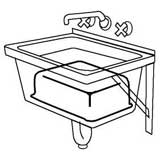
Employers have the primary responsibility for protecting the safety and health of their workers. Employees are responsible for following the safe work practices of their employers.
During Dishwashing:
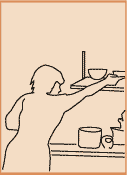
- To help limit back flexion (forward bending at the waist) while washing items in a large sink:
-
Place an object such as a plastic basin in the bottom of the sink to raise the surface up while washing items in the sink.
-
-
Rearrange work spaces so it is easier to reach for supplies used routinely and to prevent over-reaching and awkward back, shoulder, and wrist postures.
-
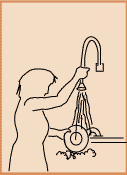
Lower your rinse nozzle to rest at mid-body height to reduce your reach.
-
Reduce your reach while rinsing dishes by lowering the rinse nozzle to rest at mid-body height.
-
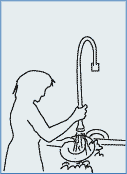
To limit over-reaching when placing glasses into racks, fill the near rows first, then rotate the rack to bring the back rows to the front.
-

Reduce overhead reaching; try to keep reaches at chest to waist level.
-
Don't overload dish racks.
-
Rack heavier items, such as plates, closest to you.
-
Empty and sort cutlery bins before they are full.
-
Use cleaning tools with good grips when heavy-duty cleaning is required.
-
Vary your activities to space out repetitive tasks.
-
Vary your technique to use different muscle groups; alternate between left and right hands.
 For more information, see Drive-thru - Prolonged Standing.
For more information, see Drive-thru - Prolonged Standing.
Employers have the primary responsibility for protecting the safety and health of their workers. Employees are responsible for following the safe work practices of their employers.
Consider implementing recommended safe work practices, including:

During Table Clean-up:
- Provide workers with containers to be used where possible to carry dirty dishes. Employees must be warned not to overfill containers, or they will have to lift or carry excessive weight.
-
Provide small rather than large containers, to limit the amount of dirty dishes that can be stacked and carried at one time.
-
-
If space permits, provide carts to put dirty dishes and heavy bussing containers on, rather having workers carry them.
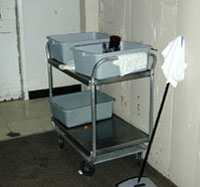
-
Choose carts with large wheels that roll easily, to prevent strain/sprain injuries to employees from pushing or pulling heavy carts.
-
-
If space permits, decrease the distance workers must carry containers. Provide close "stations" to put bussing containers on that are located near the serving and clean-up area, so that the young worker doesn't have to return dirty dishes all the way into the kitchen area.
-
Leave outdoor furniture set up outside, outdoors at night. This may substantially decrease the amount of lifting required to set up and break down outside eating areas.
-
Instruct employees to get help when moving tables and chairs or other heavy objects, rather than lifting alone.
During Garbage Removal:
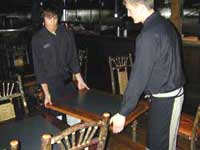
- Reduce lifting during garbage removal tasks by using garbage handling bags with wheels or garbage cans with wheels for garbage collection when possible.
- Handling bags have a frame with one side open to allow for easy disposal of garbage without reaching into and pulling bags up and out. The bags should be able to slide off the cart without lifting.
-
Limit the size and weight of these bags and provide handles to further decrease lifting hazards.
-
Use garbage cans that have a frame versus a solid can to promote ease of emptying. This will prevent plastic bag liners from sticking to the inside of the can. If the garbage bag gets stuck in the can, you must lift a lot more weight to release the vacuum than just the weight of the garbage.
-

Use anti-cling products that can be applied to the inside of your garbage can to prevent the plastic bag from sticking to the inside of the can.
-
Limit the size of garbage containers to limit the weight of the load employees must lift and dump.
-
Place receptacles in unobstructed and easy-to-reach places.
-
Install dumpsters at or below grade level.

Consider implementing recommended safe work practices, including:
-
Choose properly designed equipment like adjustable level rinse nozzles to help reduce the hazards associated with repetitive overhead and elevated reaches.
-
Provide cleaning tools with good grips.
Additional References
- Ergonomics. OSHA Safety and Health Topics Page.

